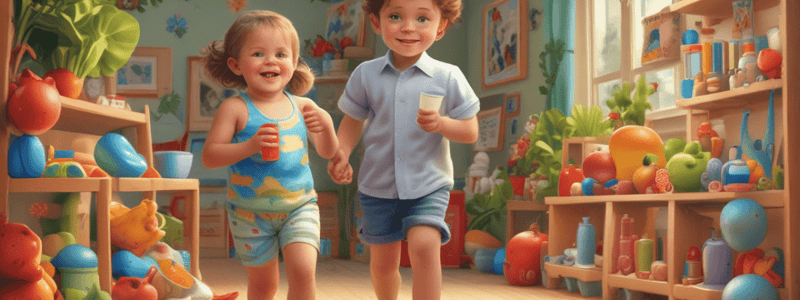Podcast
Questions and Answers
What is the typical pulse rate range for preschoolers?
What is the typical pulse rate range for preschoolers?
- 100-160 beats per minute
- 80-140 beats per minute
- 50-90 beats per minute
- 65-120 beats per minute (correct)
What developmental milestone do toddlers achieve by 12-15 months?
What developmental milestone do toddlers achieve by 12-15 months?
- Walking independently
- Mastering language
- Bladder control (correct)
- Developing fine motor skills
Which age group exhibits physical changes like rapid growth spurts and secondary sexual development?
Which age group exhibits physical changes like rapid growth spurts and secondary sexual development?
- Adolescents (correct)
- Toddlers
- School-age children
- Preschoolers
What is an important outcome of playing for children according to the text?
What is an important outcome of playing for children according to the text?
Which age group gains about 4 pounds and grows 2 inches each year?
Which age group gains about 4 pounds and grows 2 inches each year?
What are adolescents at higher risk for according to the text?
What are adolescents at higher risk for according to the text?
Flashcards are hidden until you start studying
Study Notes
- Toddlers (1-3 years) have a pulse rate of 80-140 beats per minute, respiratory rate of 22-37, and systolic pressure around 86-100.
- Preschoolers (3-6 years) exhibit a pulse rate of 65-120 beats per minute, respiratory rate of 20-28, and systolic pressure of 89-112.
- Toddlers and preschoolers experience significant neuromuscular growth, with toddlers developing bladder control by 12-15 months and mastering language by 36 months.
- Playing is important for muscle and bone development in children, leading to increased muscle mass and bone density.
- School-age children (6-12 years) show gradual approaching of adult vital sign ranges, gain about 4 pounds and grow 2 inches each year.
- Adolescents (12-18 years) experience physical changes like rapid growth spurts, reproductive system maturity, and secondary sexual development.
- Adolescents strive for independence, may display rebellious behavior, and are influenced by peer pressure in forming their identity.
- Adolescents are at higher risk for mental health issues like suicide and depression, and may develop eating disorders and engage in high-risk behaviors.
Studying That Suits You
Use AI to generate personalized quizzes and flashcards to suit your learning preferences.


